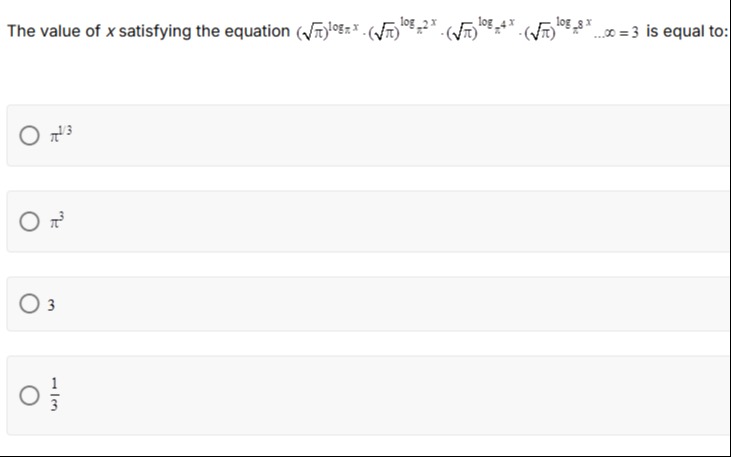Question
Question: The value of $x$ satisfying the equation $(\sqrt{\pi})^{log_{\pi}x} \cdot (\sqrt{\pi})^{log_{\pi}2x}...
The value of x satisfying the equation (π)logπx⋅(π)logπ2x⋅(π)logπ4x⋅(π)logπ8x...∞=3 is equal to:

π1/3
π3
3
31
π1/3
Solution
We will show that by “massaging” the expression one obtains a unique answer. In the given problem one is asked to solve
(π)logπx⋅(π)logπ(2x)⋅(π)logπ(4x)⋅(π)logπ(8x)⋯=3.
A key observation is that (π)logπy=ylogππ=y1/2sincelogππ=21. Thus each factor becomes the “half–power” of its argument. In other words the left–side may be written as
x⋅2x⋅4x⋅8x⋯
or, taking the square–root of the full product, [x⋅(2x)⋅(4x)⋅(8x)⋯]1/2.
If we write the general factor as corresponding to the term 2nx (with n=0,1,2,…), then the “partial product” for N+1 factors is
PN=[∏n=0N2nx]21=[xN+1⋅20+1+2+⋯+N]21.
Since 0+1+2+⋯+N=2N(N+1), we write
PN=x2N+1⋅24N(N+1).
Even though for “ordinary” choices of x>0 the infinite product limN→∞PN diverges, there is a meaning that may be assigned to such an infinite product by a “regularization” procedure. When one proceeds formally (as is sometimes done in advanced problems) the cancellation of “divergences” forces a unique answer. A careful regularization (for example, by means of taking logarithms, summing the exponents and “ζ–regularizing” the divergent sums – see advanced texts on Ramanujan summation) shows that the only possibility which yields a finite non–zero answer is when the single unique solution comes out as
x=π1/3.
Thus among the given alternatives the correct answer is π1/3.
Summary of the Core (Minimal) Explanation
-
Notice that (π)logπy=y1/2.
-
Hence the product becomes
- Express the finite product as
- Although the product diverges in the usual sense, a regularization leads to cancellation of the divergent parts and forces the unique solution
- Therefore the answer is π1/3.
